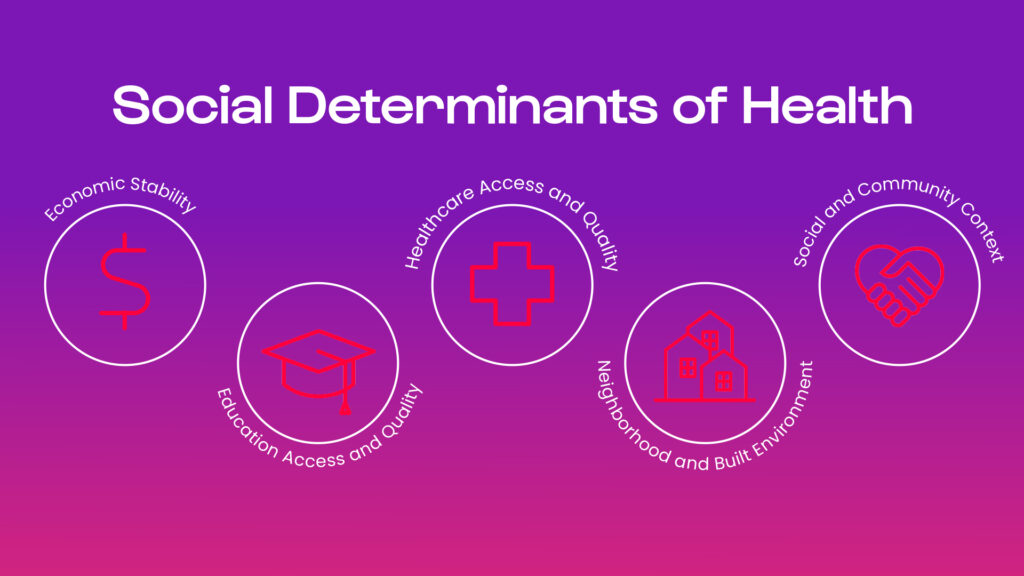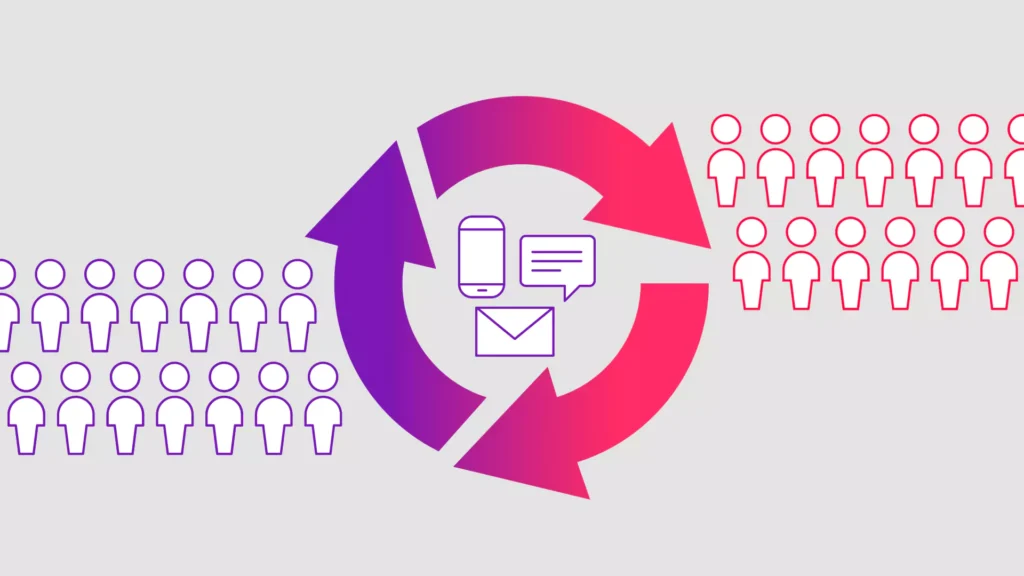A one-size-fits-all approach is an unrealistic way to communicate with patients. The same text sent to two different individuals may have entirely different outcomes depending on the unique factors affecting the lives of each patient. These factors are often referred to as social determinants of health (SDOH): “the conditions in which people are born, grow, work, live, and age, and the wider set of forces and systems shaping the conditions of daily life,” according to the World Health Organization.
Social determinants of health can have an enormous impact on the mental and physical health of an individual. The U.S. Department of Health and Human Services breaks them down into five key buckets that often overlap or influence one another. For example, a family with low economic stability is likely to not have health insurance, impeding their access to healthcare.
Social determinants of health can play an even greater role in the mental and physical development of a young child. Children are more sensitive than adults and may suffer lifelong consequences when subject to poverty, stressful environments, and trauma. A recent in-depth study of 10,504 children discovered several different SDOH pattern groups with long-term impacts. They found that children who followed pattern three (this typically included low family income, high poverty rates, high single-family proportions, low rates of health insurance, low education rates, and the lowest opportunity atlas social mobility scores) had the worst outcomes. These children suffered high levels of racism and discrimination towards immigrants (this group had a disproportionally higher Black and Hispanic population than other cohorts) and the highest rates of lead exposure which can permanently damage the brain. This pattern group had both the poorest physical and mental health across the groups and the highest rates of suicide.
Health systems must understand the unique circumstances that their populations are living in when developing their communication strategies. When asking questions and screening populations, there are several core buckets to carefully examine.
What are the Social Determinants of Health?
Economic Stability
A recent survey of oncologists found that 93% believe that SDOHs impact the long-term outcomes of their patients. Many cited economic stability as being key to cancer treatment as patients not only need health insurance but also the ability to not work for a long period. A family member may also need to step back from work to care for them leading to even more economic strain. Yet, in the United States, 1 in 10 people live in poverty, placing critical healthcare out of reach for many.
The Healthy People 2030 program aims to change that by offering increased employment programs, career counseling and childcare services. Children who grow up in economically stable homes are more likely to live in safe neighborhoods near centers of excellence, have employed parents with health insurance and receive higher levels of education and necessary services like speech and occupational therapies.
A lack of health insurance can play a huge role in patient no-shows or a low referral conversion rate. For example, Nemours Children’s Health partnered with The Harris Poll to survey parents and found that 32% said they missed their child’s medical appointment because they couldn’t pay for it.
Education Access and Quality
Studies indicate that adults who have received higher education live longer and overall healthier lives than less educated peers. Individuals who receive a good education are likely to pursue healthcare services and understand their importance. They are also more likely to have higher-level careers that offer increased payment and opportunities for health insurance.
Healthcare Access and Quality
Access to healthcare is often dependent on health insurance, and 1 in 10 people in the United States do not have health insurance. People without health insurance are far less likely to have a primary care doctor and receive routine screenings. Children without access to health insurance may also fail to receive mental and behavioral health services and physical, speech and occupational therapy. Outside of health insurance, access to healthcare facilities, especially for those in rural areas may present a significant barrier to care. Regarding maternal care, up to 36% of US counties lack obstetric providers and hospitals. It’s hard to believe this lack of maternal care still exists in the US today, and it often puts both mother and baby at risk of long-term health complications.
Neighborhood and Built Environment
Neighborhood and built environment can refer to many factors including violence, pollution (air and water), lead paint in old buildings, noise exposure leading to hearing loss and exposure to second-hand smoke. Toddlers and even older children exposed to smoke are at greater risk of asthma, respiratory infections, ear infections and slowed lung growth. The American Cancer Society has found that children exposed to secondhand smoke also have a greater risk of cancer like leukemia, lymphoma and brain tumors.
Social and Community Context
This SDOH refers to the relationship one has with family, friends and neighbors. A loving and supportive community is critical for the well-being of any child. Yet, children who live in poverty may have parents who are very stressed, mentally ill, or incapable of offering them the care that they need. Additionally, language barriers and cultural attitudes towards the US healthcare system or Western medicine may impede access. The US healthcare system has treated many communities like second-class citizens, and rebuilding trust is still a long and complex road.
Putting Social Determinants of Health Tools to Work

Children’s Wisconsin is its region’s only dedicated children’s hospital. The facility sought to eliminate common barriers to care and understand why patients weren’t showing up to appointments. Megan Sheble, Senior Project Manager on the Health Management Team at Children’s Wisconsin, saw this as a great opportunity to not only understand how SDOHs were impacting their patients but also to connect more deeply with the families they serve. They piloted Artera’s Conversation Builder workflow at several clinics with high uninsured and low-income populations. When a patient didn’t show up for an appointment, they were sent a friendly text offering five options: transportation issues, forgot, date and time did not work, took family elsewhere, or other. The team was shocked to see detailed answers come through under the “other” option, a testament to how many patients feel quite comfortable texting.
“Having a tool like Artera to be able to identify problems for us to respond to allows us to be innovative. While we can’t fix all of the problems, it challenges us to think differently, do more, and meet our patients where they’re at.”
Megan Sheble, Senior Project Manager, Health Management Team, Children’s Wisconsin
With this data in hand, the team used Artera’s Analytics Plus to take a deep dive into the most common responses. They were shocked that the top response was that families did not have winter coats and gear for children. Staff used the MRN field within Artera to identify the patients and reach out to coordinate transportation and provide winter coats. This drove meaningful interactions with their patient population and removed barriers to care for those in need. The facility launched a new initiative to offer families clothing and provided more than $5,000 in winter gear to patients, a tradition they continue every year.
Making Operational Improvements
There is no solution to solving the complex problems in healthcare that is “set it and forget it.” Any program needs to be a living and breathing platform that can continually be updated and improved. For example, Children’s Wisconsin was able to identify undeliverable messages via the Conversation Builder workflow report, which encouraged them to push a staff reminder to verify phone numbers when registering families. Utilizing data and analytics allows facilities to carefully examine data and can help determine insights like the ideal time for sending messages.
Facilities can take several key steps when developing a more personalized communication strategy:
Keep in Mind Patient Preferences: Allow the patient to choose their communication channel of choice, whether text, phone, email or a combination of the above. It’s also important to provide caregivers with access to communications for those under their care.
Personalize!: As with any modern marketing, spamming is a no-go. Try to keep messages and communications sent to patients as pertinent and ideally, unique, to each individual.
Have a Natural Conversation: Conversational messaging is critical to allow patients to ask questions and receive a response. Artera’s Trends in Patient Communications Report indicated that 69% of patients are frustrated by the inability to engage in conversational messaging with their provider. One children’s hospital in the Midwest used Artera’s conversational messaging to increase confirmation rates and reduce no-shows and late cancellations, generating an additional $6.3M in revenue.
Provide Language Support: Research suggests that those with limited English proficiency (LEP) face barriers to health care access, experience lower quality care, and suffer worse health outcomes. By addressing language barriers, patients can better understand their care needs and ultimately make better-informed decisions for their health. For example, Kheir Clinic, a community health center located in the Koreatown district of Los Angeles, California, leveraged Artera to become a COVID-19 vaccination destination for hard-to-reach patients through texting technology and multilingual outreach campaigns. They were able to effectively communicate about the vaccination process with their diverse patient population, using numerous languages such as Bengali, Thai, and Korean, successfully administering 12,500+ vaccines!
Leverage AI-Enabled Capabilities: AI tools can help take your platform to the next level by helping automate complex workflows, personalizing patient messaging, and offering patients more self-service opportunities.
Understanding your unique population and communicating with them in the way that works best for their needs will lead to successful outcomes for all. What are you waiting for? Learn more about Artera today.



